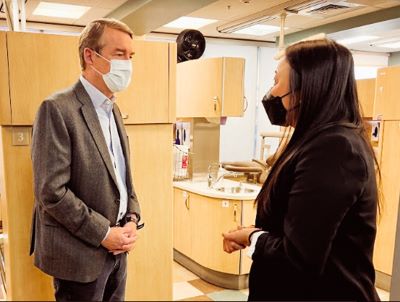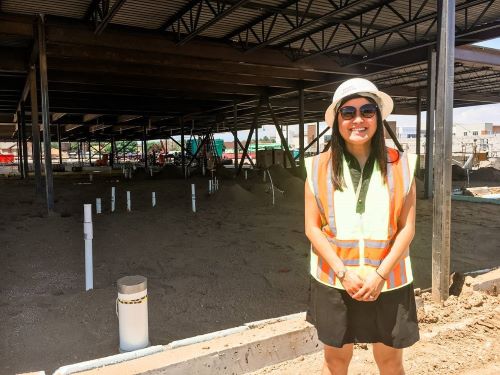Enter your email to receive the CareQuest newsletter:
August 16, 2023

As a public health dentist, An Nguyen, DDS, MPH, spends a lot of time thinking about the impact that place and space have on health outcomes. For her, the social determinants of health — the conditions in the environments where people are born, live, learn, work, play, worship, and age — shaped her path in three major ways:
- She is a part of a family of refugees. “At seven months pregnant, my mom and dad escaped Vietnam on a boat and, after 11 days at sea, were found and taken to a refugee camp in Hong Kong, where I was born,” she says.
- She is a southerner. “After the refugee camp, we were sponsored in Little Rock, Arkansas, which became my childhood home,” she says. “In Arkansas, Chelsea Clinton was my classmate in the public school system, but it’s also where I learned English as a second language and received charity care from a privately practicing dentist.”
- She describes herself as a “third culture” kid. “I have close ties to my parent country but also feel strongly assimilated into my new homeland, identifying as something culturally unique to both,” she says.
Nguyen is the chief dental officer at Clinica Family Health in Colorado. She brings her unique background and lens to her work every day, connecting dots that might not be apparent to others. She also brings a passion for quality improvement and a formalized, data-driven approach to improving care and systems that surround our work and lives. (In July, Nguyen was a panelist on “Using a Quality Improvement Approach to Improve Oral Health Outcomes,” a CareQuest Institute–National Network for Oral Health Access (NNOHA) webinar.)
Nguyen found some time after the program to tell us more about her journey into public health dentistry and to offer advice and inspiration for anyone interested in learning more about quality improvement.

How does your background influence the way you approach your work?
I tend to be more aware of other “third cultures” around me — those who don’t quite fit the norm yet seek to be and must be integrated into the whole. So, when I found myself on a prehealth professions track in college and an advisor said, “You don’t ask questions typical of a health care provider; have you considered public health?” it took very little for me to integrate into the third culture of public health dentistry.
Today, my work centers on third cultures in many ways — as a clinical provider for underserved patients, an equity champion for marginalized populations, and a systems designer to support the diverse needs of the American melting pot. It is my belief that when we support those most challenged to engage with prevailing systems, we create environments where all third culture people find inclusivity, and these are spaces and places that allow all of us to thrive.
What does an average day as the Chief Dental Officer at Clinica Family Health look like?
The essence of my work is fairly straightforward: I connect dots. In the decade plus that I have served in leadership at Clinica, listening and reflecting are the tools I use most to support growth of our access, integration of our systems, and improvement of our quality of care. They are the tools that allow me to thread together what I always hope are accurate, coherent stories of the realities that we face in health care and to promote sensitivity for the marginalized people receiving care within it.
I frequently have the opportunity to share those stories and experiences in many different forums — from leadership of my dental team to executive oversight at Clinica to advocacy in state and national professional and policy groups — all of it influenced by my “third culture kid” lens and by the honor of hearing my patients’ stories as I sit chairside.
On the webinar, you spoke passionately about your appreciation for quality improvement. Where did that appreciation originate?

a tour of a dental clinic.
For me, quality improvement is the intersection of SCIENCE + HUMANITY. There is rigor and evidence behind quality improvement (a scientific field with origins in physics and engineering), but they are inherently designed with people in mind — both the people who work within the system seeking improvement and the people who are on the receiving end of the system itself.
Early in my career, I vividly remember the huge dopamine hit after participating in my first PDSA (or Plan-Do-Study-Act cycle, a quality improvement process designed for small tests of change). I saw how it could become an outlet to process the observations and ideas that frequently only lived in my head. As an introvert and internal processor, participating in QI activities supported me to share my voice, and I immediately saw how powerful it could be for promoting equity. I have been hooked since.
Why do you think quality improvement is a valuable tool in dentistry?
Something universal that I believe connects all of us who have found dentistry as a profession is our appreciation of our connection to others. Regardless of our role in the profession, we all arrive and stay to work in dentistry because we care about helping others, and we care about making things better for the people we serve. A quality improvement approach is complementary to these aspirations. As a public health dentist, I consider quality improvement as critical . . . a tool in my toolbox as my ability to properly diagnose and treat a cavity or to plan and evaluate a health promotion program.
Can you share an example of a project that illustrates the value of quality improvement?
One of the first questions I asked when I arrived at Clinica was “How does a patient get a dental appointment?” This resulted in a list of steps that helped us see the patient’s journey, which helped us see that changes were needed to support a better patient experience. The team had lots of ideas for how we could make things better, and we tested many of them using PDSA cycles, which allowed us to identify which ideas to abandon and [which] to adapt and scale up with more testing.

Ultimately, that work allowed us to increase the rate at which our patients could complete their treatment plans from dots that would barely register on a run chart (a graph of data over time) to consistently above 70% within our first three years of focus. This has resulted in significant improvement in our patients’ experience with our system, their clinical outcomes, and staff satisfaction. This is the story that started our dental quality journey at Clinica, on which we have never looked back.
If someone is interested in dipping their toe into quality improvement, where should they start?
Start with an idea; all teams have them! With relatively little formal training, it’s possible to move that change idea into a PDSA cycle that could be tested tomorrow. Even if the test is ultimately unsuccessful, the cycle will quickly generate invaluable information about the system to inform the next test cycle that can lead to incremental improvement. A PDSA is a low-cost, low-commitment way to get invaluable data while also fostering team engagement and supporting change management.
There are also several organizations important to my journey where a new learner of QI — especially one in the oral health space — can get support, including NNOHA and the Institute for Healthcare Improvement.
Lastly, what one change would you make to improve the oral health system overnight?
Integrate — everywhere. There are so many real and perceived siloes that get in our way of improving the system.
In dentistry, how might we integrate payment systems to better support outcomes-based care? I see a tremendous amount of opportunity in value-based payment systems, for which a quality improvement approach is critical for success.
From a public health lens, integration of oral health in systems that are not conventionally considered as “dental” is critical to normalizing basic health-promoting behaviors and preventive care receipt. I envision making oral and general health wellness a part of basic education and public dialogue.
Editor’s note: Hear more about quality improvement and Dr. Nguyen’s work on the recording of “Using a Quality Improvement Approach to Improve Oral Health Outcomes.”